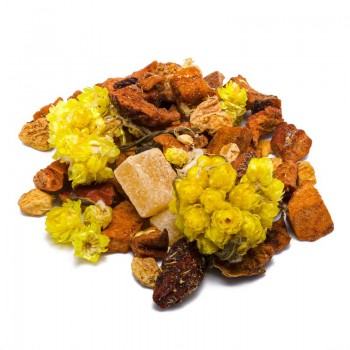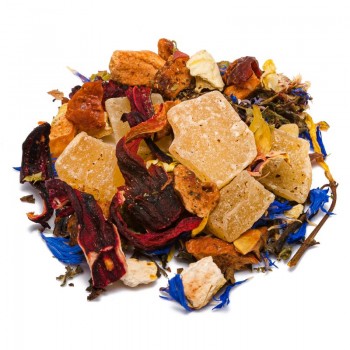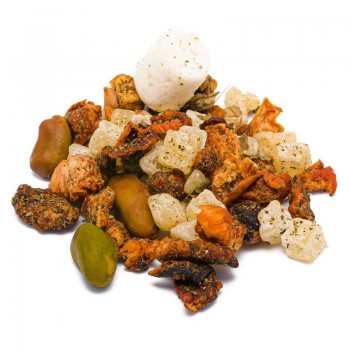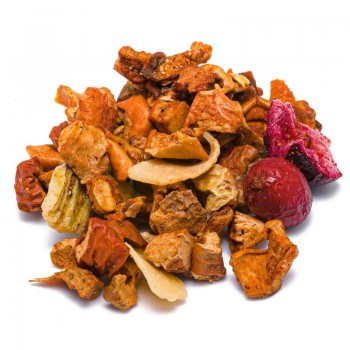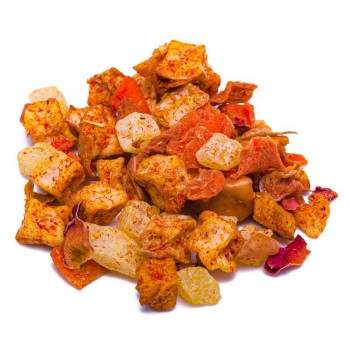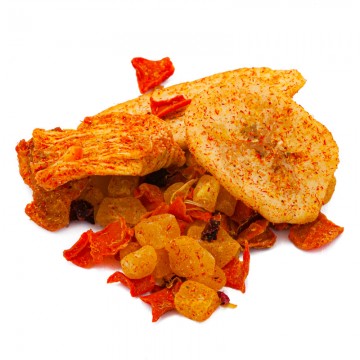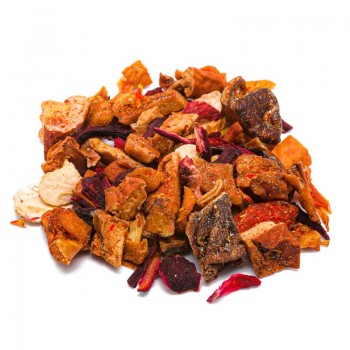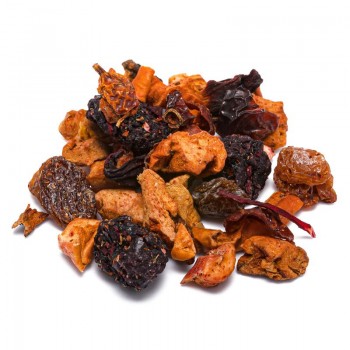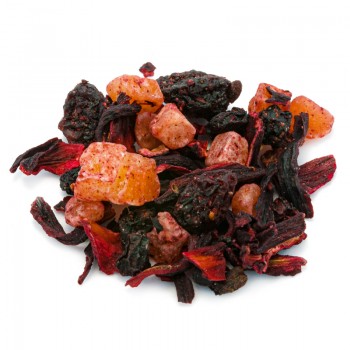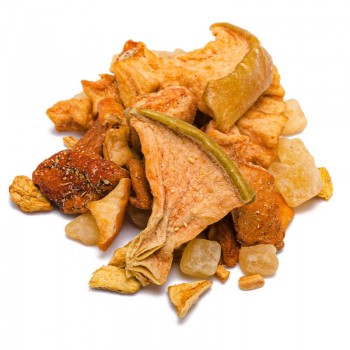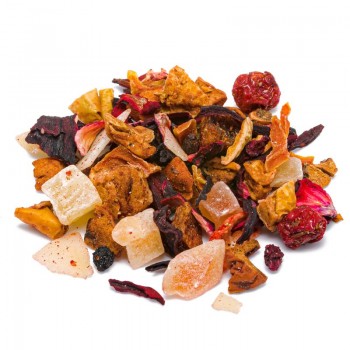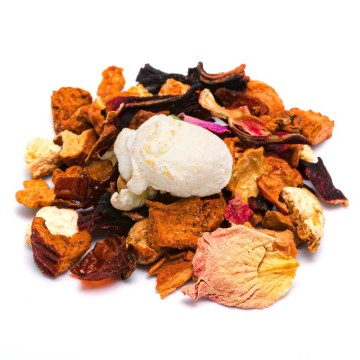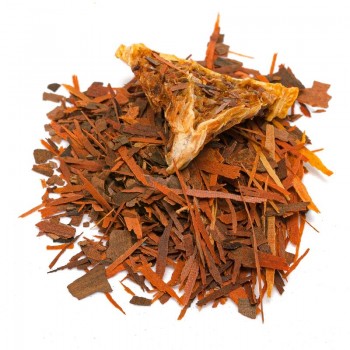Here is a naturally sweetened drink, creamy and exquisite for your sugary sips without too much sugar. It is a tea that contains moisturizing and refreshing ingredients, rich in fruit and with the refined note of hibiscus, which accentuates the sweetness. Berries such as elderberries and savory strawberries are enhanced, with a harmonious and lively effect at the same time. The orange peels add a citrus and aromatic touch to the infusion, perfect for a pleasant break for relaxation and reflection.
It leaves a creamy aftertaste, reminiscent of the classic combination of strawberries and cream. Several ingredients come from sustainable, crops, and the infusion is enhanced by totally natural aromas.
Strawberry and cream infusion: properties and benefits
The nutrients in the blend are known for their well-being properties, as both strawberry and hibiscus are rich in vitamin C and other antioxidants. Elderberry is also known, among other things, for its feel-good properties for the immune system. An elderberry infusion also helps the respiratory tract. The natural composition of the blend gives, through strawberries and elderberries, an excellent antioxidant effect, an ally to face the winter cold and soreness. The hibiscus, the apple and the orange peel favor digestion, with an effect that starts from the correct intestinal transit to continue with the diuretic qualities. Strawberry and elderberry, in fact, have properties useful for promoting diuresis and the expulsion of excess liquids. The purifying action becomes useful against water retention and to expel toxins. A "creamy" strawberry infusion, therefore, which simultaneously helps not weigh down the body, and nourishes with natural sugars.
Origins and History of cultivation
Wild strawberries (Fragaria) are red, sweet and soft fruits, known for millennia to many populations of the planet, since they are found throughout the northern hemisphere, with about 20 different species naturalized on various continents. With over 600 varieties of strawberries that vary in taste and size, although they all have similar characteristics: heart shape and red fleshy texture. The two most common strawberry species are the Virginia strawberry (Fragaria virginiana) and the wild strawberry (Fragaria vesca). The origin dates back to more than 2200 years ago, and we know that they grew spontaneously in Italy around 200 BC. If initially they were eaten as wild fruits, small and not always tasty, over time strawberries were cultivated. Cultivation in Europe began in the 14th century, when wild strawberries from the woods were brought to the grounds of private gardens, on a small scale.
With the arrival of the colonists in America, in the sixteenth century, the Virginia strawberry was discovered, much larger in terms of plant and fruit. Wild American strawberries were brought to Europe to be studied, and several hybrids have since been born. Until the creation of the common garden strawberry. Large and juicy, the garden strawberry was first grown in France in the 18th century, using a combination of Virginia strawberries. Wild strawberries were popular among Native Americans, harvested and used. The leaves, stems and roots were used for medicinal applications and treatments.
The Navajo tribe, in particular, considered strawberries an important source of well-being. It is good to know that strawberries are not considered real berries, but are "receptacles". The small, yellow, seed-like pods are found on the outside of the strawberry's pulp and are known as achenes: technically, the seeds are found inside them.
Fruits and flowers
The components of the infusion are many, and the mixture contains leaves and flowers of different origins.
The Malus domestica plant of the Rosaceae family gives us apples. It is a tree native to Asia, now spread all over the planet. The fruits differ in colors and in many varieties, and have been used in human nutrition for thousands of years. Hibiscus is a flower that derives from the tropical plant Hibiscus sabdariffa, of the Malvaceae family. It is native to Africa but widespread in many tropical and subtropical regions of the world (Thailand, China and Mexico). There is also the tropical hibiscus variety. Its large edible flowers are known for their bright colors and scent.
Sambucus nigra is the tree from which the elderberry derives. This is the European or black elderberry, which grows in Europe, North America, Asia and northern Africa. The dark purple berry wasknown in folk medicine to treat colds and flu, as well as edible.
The strawberry comes from the flowering plant of the genus Fragaria, which includes over 20 species. It belongs to the rose family (Rosaceae), and today it gives many varieties grown all over the world, among which the most widespread is Fragaria ×ananassa - large-fruited strawberry. Strawberry is not a real berry but a pseudo-carpus. The orange tree is Citrus sinensis L. belonging to the Rutaceae family. Donate sweet oranges, which are distinguished from bitter oranges. Many scholars think that Citrus sinensis is a hybrid plant, a cross between the pomelo and the mandarin born in China.
Nutritional values of strawberry infusion
The infusion makes available vitamin C and various antioxidants, anthocyanins and polyphenols, contained in the various ingredients. In addition to mineral salts such as potassium, iron, calcium.
How to use the ingredients in the infusion
The infusion is obtained by placing in a cup (250 ml), about 3-5 grams the strawberry and cream mixture with water at 100 °C. Leave to infuse for 10 to 12 minutes before drinking. Add honey or sugar if you wish, even if the drink is already naturally sweet.
Strawberry tea: side effects and contraindications
To avoid the undesirable effects of the infusion, it is necessary to respect the recommended doses per cup. Do not exceed in consumption for too long periods. Excessive intake can cause diarrhea or constipation, stomach pain, intestinal gas and gastrointestinal disorders. It is advisable to pay attention to all the ingredients of the infusion, for those suffering from food allergies. The strawberry could trigger reactions with urticaria and epidermal burning in sensitive subjects. Caution is advised in pregnant or breastfeeding women.

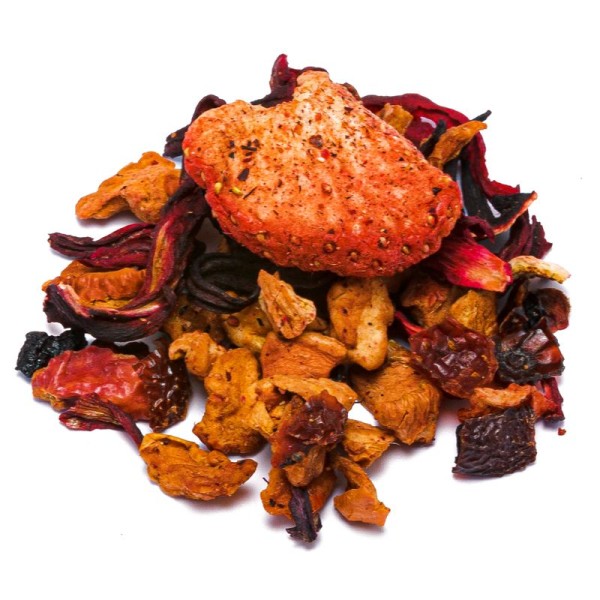









 No reward points for this product.
No reward points for this product.
